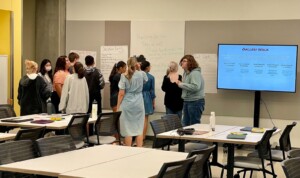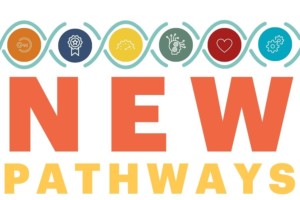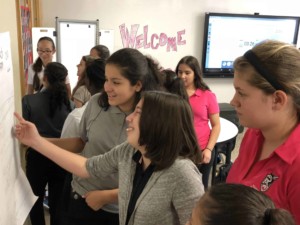Education’s New and Necessary Narrative
Key Points
-
A panoply of possibilities exists as education paves a new path forward.
-
Building learning around the principle of our interrelatedness with the natural world will continue to be pivotal.

While many in northern latitudes find themselves in frigid climates for the winter holiday, I stand amidst a humid forest. Though I do not pretend to fully comprehend the intricacies of science, I know how beneath my feet there is a complex underground web of communication. One pre-existing the world wide web, some in jocularity calling it the “wood wide web.” Ultimately it drowns my mind in mysticism by how it exactly functions. Roots, mycorrhizal fungi, and bacteria all “speaking” to each other, connect the life I look upon. “A tremendous amount can be learned from this,” I think to myself. How might this tether to learning and be of benefit to the future of education?”
Seemingly, our schools are affixed to economic and political systems fraught in everything but the natural world. Juggernauts of touted innovation, much distance remains from reaching any sort of tipping point. Yet, there appears to be some rising levels of consciousness, where practices and models are beginning to be implemented in answer to the question, “What does the world need most?” And as an educator myself, I remain hopeful that education as we have known it for the past 150 years will be transformed. Interdependence and connectedness are possibly as fundamental to this “revolution” as food, shelter, or any of our other physiological needs.
Human-Centered Education, The Path Forward
A peremptory search for “methodologies of education” results in 26 different approaches. Of keen interest are place-based, nature-based, and sustainability-based learning, all three aligning with what some might call human-centered education. Going beyond even this, might be ideals of biocentrism and holding all life in equal moral standing. Whatever the case, such methodologies aim to positively impact the quality of life for all. Not only is this a noble reason for education, but there is a fittingness for the times in which we are living. Author Jeremy Lent suggests how education could be re-envisioned so its “goal is to transform from preparing students for the corporate marketplace to cultivating in students the discernment and emotional maturity required to fulfill their life’s purpose as valued members of society.” Lent, a former internet company CEO, and award-winning author, is described by Guardian journalist George Monibiot as one of the greatest thinkers of our age. “Cultivating in students the discernment and emotional maturity required to fulfill their life’s purpose.” Could there be any more of a meaningful shift in the purpose of our schools? It is revolutionary but also plausible.
Phasing out the horse for urban transportation and rural labor took but 50 years. On a larger scale and protracted over many more years, is how societies transitioned from foraging to farming. In either case, the “impossible” became reality. Historians argue that pivotal changes such as these did not just randomly happen. They required foresight and were set into motion with great intention. So too, education can change its “operating system.” From industrial models confounded upon compliance to experiences much more human and rooted in the natural world. Models of empowerment, purpose, and contribution, where technology does not use us but where we use technology to move society forward. As tools to connect, not to distract or divide.
Interdependence and connectedness are possibly as fundamental to this “revolution” as food, shelter or any of our other physiological needs.
Matt Piercy
Intentionality Central in Paving Way for a New Paradigm
Before rushing headstrong into adopting technology, we are wise to always question: how might technology support the methodology we are using? Dr. Lisa Marie Blaschk, program lead for the online Home Hub at Learnlife in Barcelona, Spain considers this conversation a mainstay of how technology is intentionally used. “Tech should never be seen as the answer to educational needs, but always as a means for supporting learning.” Having worked for the last two decades as a researcher and teacher on distance education and online learning, Dr. Blaschk emphasizes how the use of tech is to support the learner’s pathway in providing some initial structure until s/he can begin to direct and determine learning. “Further, tech is utilized to support development of relationships with learners, for dialogue, for communication, and for providing learning structures/pathways.” A salient point remains, the use of technology is intentional.
Another example juxtaposing the past with the future, is being set by the decentralized Amish, a religious group who immigrated to the US in the 1700s. Alex Mayyasi regards how the Amish make slow and deliberate decisions as a collective. “Rather than rushing optimistically or blindly into the future, they move forward cautiously.” Mayyasi cites Donald Kraybill, professor of Anabaptist and Pietist Studies, in The Riddle of Amish Culture (1989), “The Amish adopt technology selectively, hoping that the tools they use will build community rather than harm it.”
Nature’s Original AI
Not surprisingly, technology is not atop the list of top 10 job skills of tomorrow. According to The World Economic Forum, critical thinking and problem solving however are. Thinking about and solving problems like how to integrate technology is paramount. Surely, greater adoption of technology will remain important yet, “newly emerging this year are skills in self-management such as active learning, resilience, stress tolerance and flexibility.” Nature definitely attests to these same skills, with wisdom that supersedes our imagination. One such example is the brilliance of single-cell slime molds. Stephanie Pappas published in LiveScience, “New research finds that slime molds, goopy and rather uncharismatic organisms that lack a nervous system, can adapt to a repulsive stimulus and then pass on that adaptation by fusing with one another.” Lent referred to such capabilities as being “beyond the most advanced supercomputer” and what he calls the original AI, Animate Intelligence.
Before I step out of the forest, I take in one last deep breath. Trees like these are inaccurately reported to produce 20 percent of the world’s oxygen, yet through an exaggerated figure, I still feel an overwhelming sense of optimism. Beneath my feet exists an uncharted neural network working in harmony. Where but one teaspoon of soil contains many miles of fungal filaments. More microbes than there are people on this planet! The word “possibility” is of the utmost essence as I consider the panoply of positive directions educational systems can take. The current narrative is decaying, soon to be replaced by one much more in balance. Where compassion, interrelatedness, and systems thinking are integral. One where we no longer are separate, in search for the forest through the trees. Rather, we recognize our being interrelated with the natural world and build learning around this principle. We are the trees! The choice is ours.
Matt Piercy works at the International School Bangkok. You can follow him on Twitter @mpiercy35.







0 Comments
Leave a Comment
Your email address will not be published. All fields are required.